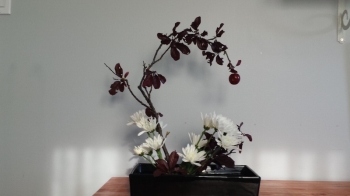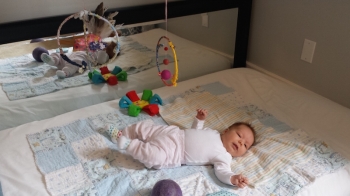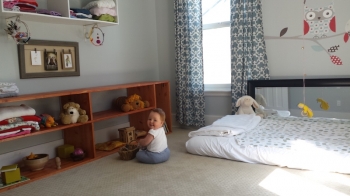As my husband Jason and I prepared to welcome Adelaide into our lives nearly ten months ago, I thought about the kind of home we wanted to create for her. I didn’t want to make a nursery in the ordinary sense, buying a crib and furniture. Instead, I reflected on the principle that infants and young children trust the world completely and absorb their environment with great openness. In the early years, the infant’s unconditional openness is incapable of discriminating, and the environment and its atmospheric impressions lay the basic foundation for the child’s physical, emotional, intellectual, and spiritual health.
As I reflected on the principle of early childhood education, my mind kept returning to ikebana, the art of Japanese flower arrangement, and some of its fundamental principles. The Contemplative Early Childhood Education degree at Naropa requires students to study a traditional Japanese art, and I chose ikebana. Initially, I felt the class to be a bit of a filler—fluff, so to speak. It was lovely learning how to arrange flowers, but I didn’t fully appreciate the connection between flower arranging and educating young children. The connection eluded me for years. Then, as Adelaide’s due date drew closer and I took the time to create our home environment, I realized that it was through the practice of ikebana that I had been introduced to a more refined awareness of space—the very key to the home I wanted to create for Adelaide.
Ikebana, as a form of meditation, allows the practitioner to awaken to a certain artistic sensibility—one that anyone can cultivate. This sensibility is not about developing an artistic skill, like drawing; rather, it is about cultivating the art of being fully human and developing a more refined capacity to feel the innate aliveness and goodness of the natural world. Ikebana is a practice of relating to things as they are, directly, simply, and with a great sense of courage—as once a branch has been cut, it cannot be uncut. Since the day we brought Adelaide home from the hospital, these principles have been of great benefit.
When making an ikebana arrangement, the first branch symbolizes the Heaven Principle, which represents space and the vast potential of the open sky. Much like placing the first branch in the kenzan (the iron base used in ikebana to hold the branches), I had to first recognize the vast, open potential inherent in the space I wanted to create for Adelaide. Much like in ikebana, I began by cutting away the stems and leaves that cluttered and confused the stronger form of the main branch and removing what didn’t work in the environment. First I ruled out a crib: I didn’t want a crib for Adelaide. I wanted her to have a floor bed to give her access to that vast, open potential and the freedom to gaze around her room freely, unrestricted by bars that would distort the view. Later, she would have the freedom to explore the space when she was ready to do so. Part of developing early self-confidence is in providing opportunities for the child to feel capable and confident to explore the environment. I felt the floor bed gave Adelaide the maximum freedom within her space.
The second branch placed in the kenzan, when practicing ikebana, represents the Earth Principle. It is the ground that relates to the vast potential of the Heaven Principle. It represents the willingness to be present to our real life experiences. In this regard, the second step in designing Adelaide’s room was to create a space with a few carefully chosen materials for her to explore and “play” with once she began to move. We hung a small wooden dowel above her bed, to which I attached a mobile for her to explore visually. As she developed, we reattached the mobile to a wooden ring with two small bells attached. When she began to swing her arms, she hit it and made a pleasing sound. We also made a low, sturdy bookshelf and carefully selected a few toys for her to discover and explore: rattles, a large felt ball, a wooden bowl, and two interlocking wooden disks. It has been my practice to be attentive and notice whether these first toys would offer her enough challenge but not too much, which might cause frustration and ultimately lead her to give up. This is where the daring quality of ikebana practice comes in. It takes much courage in today’s world of jolly jumpers, exersaucers, and the endless array of plastic toys to embrace the simplicity of a few very carefully selected items and to trust that less is truly more.
When Adelaide first reached out and intentionally grasped the ring hanging above her bed, it gave me great confidence that she was, in fact, expressing the third and final principle of ikebana flower arrangement. When placing the final branch, you are joining the Heaven and Earth principles with the Human Principle, which creates the great harmony of the ikebana arrangement. And when Adelaide first reached out and acted upon her environment with intention, she literally “changed the world” and introduced the Human Principle into the space we had created for her.
Some people have asked me if I am worried that when she gets older she will have the freedom to move around in her room when we are asleep. I’ve never been afraid of this. Much like in ikebana, when a student has mastered the traditional form they are encouraged to pursue freestyle arrangements because they have already cultivated a deep appreciation of and sensitivity to the practice of looking and seeing. Form in ikebana invites the practitioner to stop and intentionally explore the moment of experimenting with the branches and flowers with a deep mindfulness of the natural order and the vast potential of the Heaven Principle, the grounding Earth Principle, and our role in interacting with these as the Human Principle. Cultivation of mindfulness gives rise to a sense of freedom, and we naturally choose a wholesome approach because we are then in touch with our self-confidence, which naturally opens to opportunities to be in touch with our heart. So, when I am asked if I am afraid Adelaide will be free to play in her room by herself, I say, “No, not at all.” Instead, I rejoice with confidence, knowing I have given her the space to find her own sense of fulfillment as she grows toward independence in a developmentally appropriate environment.

















